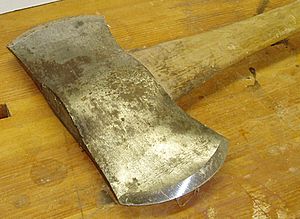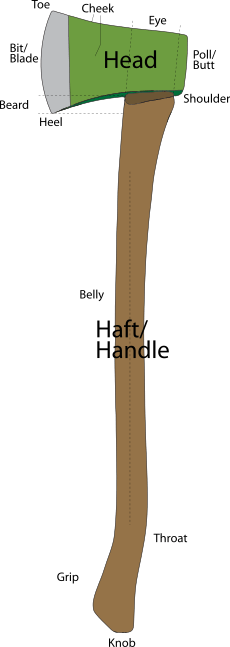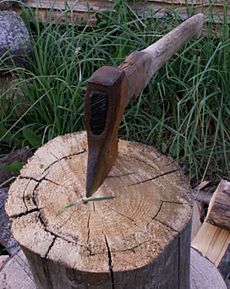Axe facts for kids
An axe is a very old tool used to shape, split, and cut wood. It's also spelled "ax."
The first axe was probably the hand axe from the Stone Age. It didn't have a handle.
Long ago, axes were even used as weapons by soldiers. Today, you usually see axes used by woodcutters and firemen.
Axes are like simple machines, specifically a type of wedge. They are usually made of metal, like steel or iron. Their handles can be made of metal or wood.
Contents
History of the Axe
The very first axes were stone tools called hand axes. People used them without handles. Their cutting edges were made by chipping (or knapping) flint or other stones.
Axes with ground (smoothed) cutting edges appeared later, during the Neolithic period (around 4,000 to 2,000 BC). The first real axes with handles are from the Mesolithic period (around 6000 BC).
Not many old wooden handles have been found. But it seems axes were often held by wedging the stone head into the handle. People used sticky birch-tar and raw animal hides to hold the blade firmly in place.
Sometimes, a short piece of deer antler was used. This "antler sleeve" helped stop the handle from splitting. It also made the impact on the stone blade softer. The antler was hollowed out to fit the axe head. Then, a handle was put through the antler or into a hole in the handle itself.
Finding stone axes in different places helps us learn about old trade routes. Scientists can study the stone to find out where it came from. In Europe, many "axe factories" existed in the Neolithic period. These were places where thousands of stone axes were made.
Stone axes are still made and used today in some parts of Papua, Indonesia. The Mount Hagen area in Papua New Guinea was a major place for making them.
Parts of an Axe
An axe has two main parts: the axe head and the haft.
The axe head has a cutting edge called the bit (or blade) at one end. The other end is called the poll (or butt). Some axes have two bits, one on each side. The top corner of the bit is the toe, and the bottom corner is the heel. The flat sides of the head are called the cheeks. Sometimes, there are lugs where the head meets the handle. The hole where the handle fits is called the eye. A part of the bit that hangs down below the rest of the head is called the beard. A bearded axe has a very long beard, making the cutting edge much taller.
The axe haft is also known as the handle. In the past, it was usually made from strong wood like hickory or ash. Today, many axe handles are made from tough man-made materials. Old axes, like the tomahawk, often had straight handles. These handles were round and just wedged into the axe head without extra pins.
Modern handles are often curved. This helps you get a better grip and makes swinging the axe easier. They are also securely attached to the head. The shoulder is where the head joins the handle. This part is often oval or rectangular. Small metal or wooden wedges help hold it tightly. The belly is the longest part of the handle, where it curves slightly. The throat is where it curves sharply down to the short grip. The very end of the handle is called the knob.
Types of Axes
Axes come in many shapes and sizes, each designed for a specific job.
Axes for Cutting or Shaping Wood
- Felling axe: This axe cuts across the grain of wood. It's used for chopping down trees (called felling). It can have one or two cutting edges (bits). Felling axes need to be very sharp to cut wood fibers well.
- Splitting axe: Used to split wood along the grain. The bit of a splitting axe is shaped more like a wedge. This shape pushes the wood fibers apart instead of cutting through them.
- Broad axe: Used for precise splitting or hewing wood along the grain. Hewing means shaping round logs into square timbers for building. Broad axes often have a chisel-like bit, with one flat side and one angled side. This helps with more controlled work.
- Adze: This tool has a head that is set at a right angle to the handle, unlike a regular axe. Instead of splitting wood sideways, it's used to flatten a surface on a horizontal piece of wood. It can also be used like a pickaxe to break up rocks or clay.
- Hatchet: A small, light axe designed to be used with one hand. It's great for camping or traveling.
- Carpenter's axe: A small axe, a bit bigger than a hatchet. It's used in traditional woodworking and log-building. It has a long beard and a special notch for your finger. This allows for a very precise grip. The poll (back of the head) can also be used as a hammer.
- Hand axe: A small axe used for general chopping, similar to a hatchet.
- Mortising axe: Used to create mortises. A mortise is a hole or slot cut into a piece of wood, often for a joint. You might drill two holes first, then use the axe to remove the wood between them. Some mortising axes have one blade. Others, like the twybil, have two blades. One blade cuts the wood fibers, and the other helps lever out the waste wood.
Images for kids
-
A collection of bronze socketed axe blades from the Bronze Age found in Germany. These were important tools and also used as a way to store value.
-
An axe from the Shang Dynasty
-
A jade axe from the Shang Dynasty
-
A collection of old Australian cutting tools. This includes broad axes, broad hatchets, mortising axes, carpenter's axes, and felling axes. Also shown are five adzes, a corner chisel, two froes, and a twybil.
-
A Firefighter with a fire axe.
See also
 In Spanish: Hacha para niños
In Spanish: Hacha para niños















